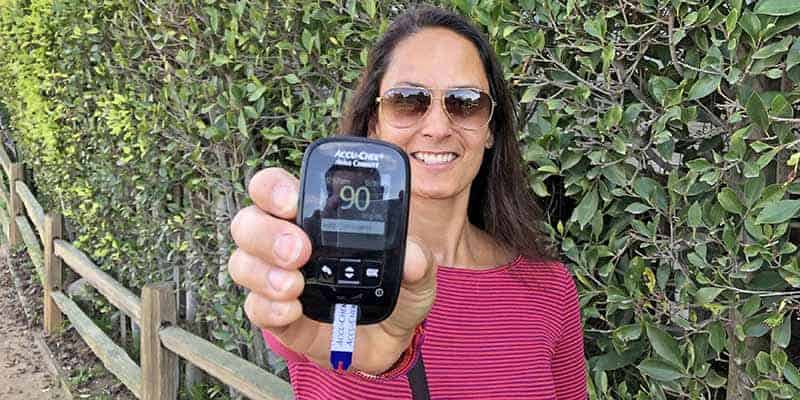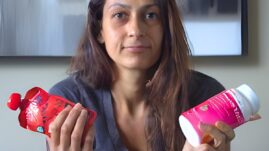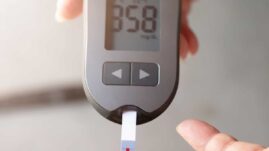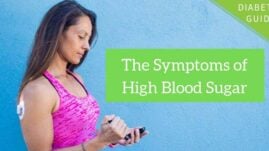Your blood glucose (sugar) levels are a critical part of your overall health and your body’s ability to function properly.
For those of us with diabetes, striving to achieve “normal” blood sugar levels is a constant, hour-by-hour pursuit. And it isn’t easy.
In this article, we’ll look at normal blood sugar levels and goal ranges for people without diabetes and recommended blood sugar goals for people with prediabetes, type 1 diabetes, and type 2 diabetes.

Table of Contents
- Normal blood sugar ranges in people without diabetes (chart)
- Recommended blood sugar ranges in people with diabetes (chart)
- How do you know what your blood glucose level is?
- Diagnosing prediabetes, type 1, and type 2 diabetes
- Your A1c and blood sugar goals
- Your blood sugar isn’t just because of what you eat
- Final thoughts: Still frustrated with your blood sugar and A1c results?
Normal blood sugar ranges in people without diabetes (chart)
For a person without any type of diabetes, blood sugar levels are generally between 70 to 99 mg/dL (3.9 to 5.5 mmol/L) fasting and under 140 mg/dL (7.8 mmol/L) after a meal.
Here are the normal blood sugar ranges for a person without diabetes according to the NIH:
| Fasting Blood Sugar (e.g., In the Morning Before Eating) | Less than 100 mg/dL (5.6 mmol/L) |
| 1 to 2 Hours After a Meal | Less than 140 mg/dL (7.8 mmol/L) |
| 2 to 3 Hours After a Meal | Less than 100 mg/dL (5.6 mmol/L) |
Recommended blood sugar ranges in people with diabetes (chart)
Here are the generally recommended blood sugar ranges for a person with diabetes according to the ADA:
| Fasting Blood Sugar (e.g., In the Morning Before Eating) | 80 to 130 mg/dL (4.4 to 7.2 mmol/L) |
| 1 to 2 Hours After a Meal | Less than 180 mg/dL (10.0 mmol/L) |
Learn more about fasting and after-meal blood sugar levels in: Blood Sugar Chart: Blood Sugar and A1c Targets.
How do you know what your blood glucose level is?
Unless it’s fairly high or low, you generally can’t feel what your blood sugar level is. And in fact, you may not even be able to tell from physical symptoms when it is high or low.
The best way to know your blood sugar level is to either check it with a traditional glucose meter or use a CGM (continuous glucose monitor) device.
For a glucose meter, you do a finger-stick with a lancet, put a drop of blood onto a test strip, and then insert the strip into the meter for a reading. With a CGM, readings are taken from the interstitial fluid (the fluid between the cells) about every 5 minutes via a sensor inserted just under the skin.
Diagnosing prediabetes, type 1, and type 2 diabetes
The following are tests that may be used by your healthcare provider to determine if you have diabetes:
Tests used to diagnose diabetes
Fasting plasma glucose test
This test measures your glucose level at a single point in time, typically after you have been fasting (nothing to eat or drink except water) for at least 8 hours.
Random glucose test
This test measures your glucose level at a single point in time and may be given at any time, whether you have fasted or not.
Oral glucose tolerance test (OGTT)
For this test, you will have a blood sample taken after fasting for at least 8 hours. Next, you will drink a liquid high in sugar and will have another blood sample taken after 2 hours to see how your blood glucose levels have changed.
(In those who are pregnant, glucose will be checked every hour for 2 to 3 hours to test for gestational diabetes.)
A1c test
This blood test reflects your average glucose levels over the previous 2 to 3 months. You can eat and drink prior to having an A1c test.
A repeat of these tests is typically required to confirm a diabetes diagnosis.
Test results for diagnosing diabetes (chart)
The following blood sugar and A1c results (a measure of glucose control over the previous 2 to 3 months) are used to diagnose prediabetes and diabetes, according to the ADA:
| A1c | Fasting Glucose | 2 Hours After a Meal | |
| Prediabetes | 5.7 to 6.4 percent | 100 to 125 mg/dL (5.6 to 6.9 mmol/L) | 140 mg/dL to 199 mg to dL (7.8 to 11.1 mmol/L) |
| Diabetes (type 1 or type 2) | 6.5 percent or higher | 126 mg/dL (7.0 mmol/L) or higher | 200 mg/dL (11.1 mmol/L) or higher |
Learn more about diagnosing diabetes in: Types of Diabetes.
Please note: Type 1 diabetes tends to develop very quickly, which means that by the time symptoms are felt, blood sugar levels are often well above 200 mg/dL all the time. For many people, symptoms come on so quickly that they are dismissed as a lingering flu or another seemingly ordinary virus.
By the time blood sugar levels are checked, many people with undiagnosed type 1 diabetes may have levels above 400 mg/dL or higher.
If you suspect that you or a loved one has type 1 diabetes, visit your primary care or urgent care immediately and ask for a urine test to measure ketones in addition to checking blood sugar levels and A1c.
Read more about ketones at diagnosis in: How to Avoid Diabetic Ketoacidosis (DKA).
Your A1c and blood sugar goals
Managing any type of diabetes is far more complicated than giving a person some insulin and telling them to keep their blood sugars within X and X mg/dL. If you’ve lived with diabetes for more than a few days, you probably already know this.
What is A1c?
“A1c, also known as hemoglobin A1c, HbA1c, glycated hemoglobin, or glycohemoglobin, is a blood test that measures your average blood sugar over the last 2 to 3 months,” explains Christel Oerum, MS, in Diabetes Strong’s guide to lowering your A1c.
Although the test reflects the glucose attached to hemoglobin (the protein in your red blood cells) over the past 2 to 3 months, the blood sugar levels in the 2 weeks leading up to your A1c test influence the results the most. Essentially, higher blood sugar levels during this period result in more glucose binding to hemoglobin.
Translating your A1c to a blood sugar level
Using this simple calculator from the ADA, you can translate your most recent A1c result to an “eAG,” or “estimated average glucose level.”
You can also use this translation when working to improve your A1c and achieve closer to normal blood sugar levels.
For instance, if you know an A1c of 6.0 percent equates to an average blood sugar level of 126 mg/dL (7.0 mmol/L), then you can look at your current blood sugar results on your CGM and meter and pinpoint what time of day you’re frequently higher than that level.
| A1c | eAG |
| 6 percent | 126 mg/dL |
| 7 percent | 154 mg/dL |
| 8 percent | 183 mg/dL |
| 9 percent | 212 mg/dL |
| 10 percent | 240 mg/dL |
| 11 percent | 269 mg/dL |
| 12 percent | 298 mg/dL |
Normal blood sugar levels in a person without diabetes can result in an A1c of 5.6 percent or lower.
Just a decade or two ago, it was rare for a person with type 1 diabetes to achieve an A1c result below 6.0 percent.
Thanks to new and improved insulin and better technology like CGMs, smarter insulin pumps, and hybrid closed-loop technology (which allows some insulin doses to be automatically delivered), more people with diabetes are now able to safely achieve A1c levels in the higher 5 percent range.
Why your A1c matters
In a nutshell: Your A1c is one of the clearest indicators of your risk for developing diabetes complications like neuropathy (nerve damage), retinopathy (a type of eye disease), nephropathy (kidney disease), cardiovascular disease, and severe infection in any part of your body that requires healing.
For instance, a small cut on your toe could become infected due to high blood sugars, struggle to heal, and become severe enough that the infection could require an amputation.
The general guidelines from the ADA recommend an A1c level of less than 7.0 percent to help prevent diabetes-related complications. Lowering your A1c closer to 6.0 percent may further reduce the risk of microvascular complications (those impacting the small blood vessels), such as those affecting the eyes (retinopathy), kidneys (nephropathy), and nerves (neuropathy).
Some people with diabetes aim for A1c levels in the 5s and lower — especially those who follow strict low-carb diets like the ketogenic diet and the Bernstein diet. However, this hasn’t been proven in research as especially necessary, nor is it reasonably achievable for the larger population of people with diabetes.
It’s also important to remember that your blood sugar levels and your A1c are just information that tells you whether your body needs changes in factors like insulin, other diabetes medications like metformin, your nutrition, or your physical activity.
If you don’t like the number you’re seeing on your glucose meter or your A1c results, use that number as motivation to make changes (with the support of your diabetes healthcare team) in how you safely manage your diabetes in order to get different results.
Determining the right A1c goal for you
Just because a blood sugar range of 70 to 130 mg/dL (3.9 to 7.2 mmol/L) is considered the healthiest for people with diabetes doesn’t necessarily mean that’s the appropriate goal range for you — especially if you have type 1 diabetes, or take insulin as a person with type 2 diabetes.
The reason this may not be the right goal for you is that extremely tight blood sugar management in people taking insulin can potentially lead to frequent hypoglycemia (low blood sugar), which can be dangerous.
Achieving extremely tight blood sugar management also generally requires a strict nutrition plan, very frequent blood sugar monitoring, precise medication management, and, often, years of experience studying your blood sugar levels.
Your A1c goals should be set in close consultation with your medical team, who can help balance the benefits and risks of different targets based on your health status, lifestyle, and preferences.
Older adults with cognitive or functional limitations or severe comorbidities (major additional health issues) may have a less-stringent A1c goal of less than 8 percent.
It is also worth noting that your A1c targets can change over time as your diabetes management evolves.
A1c goals should be individualized
“A1c goals should be individualized based on the individual capabilities, risks, and prior experiences,” explains Gary Scheiner, MS, CDCES, founder of Integrated Diabetes and author of “Think Like a Pancreas“.
“For example, we generally aim for very tight A1c levels during pregnancy and more conservative targets in young children and the elderly.”
Scheiner highlights important factors that could justify aiming for a higher A1c, like hypoglycemia unawareness, a condition in which a person with diabetes no longer feels the typical warning signs of low blood sugar.
Hypoglycemia unawareness can put you at significant risk for severe low blood sugars that have the potential to be life-threatening. To reduce that risk, you would aim for higher target blood sugar ranges.
“Someone with significant hypoglycemia unawareness and a history of severe lows should target higher blood glucose levels than someone who can detect and manage their lows more effectively,” adds Scheiner.
“And certainly, someone who has been running A1cs in double digits [like 10 percent or higher] for quite some time should not be targeting an A1c of 6 percent … better to set modest, realistic, achievable goals.”
Read about reducing your A1c in: How to Lower Your A1c and How to Lower A1c Naturally.
Your blood sugar isn’t just because of what you eat
It’s easy to believe that your blood sugar levels are impacted only by what you eat and how much you exercise, but people with type 1 and type 2 diabetes who check their blood sugars frequently could tell you otherwise.
It’s especially important to keep this in mind when looking at your own blood sugars and your goals, because there are certain variables and challenges that impact blood sugar levels that you can’t always control.
For example:
- Menstrual cycles: often raise blood sugar and insulin needs
- Adrenaline rushes from competitive sports, heated arguments, roller coaster rides, and other intense situations: raise blood sugar and insulin needs
- The common cold and other illnesses: usually raise blood sugar and insulin needs
- Hormonal changes due to puberty and healthy growth in young adults: raise blood sugar and insulin needs
- An injury that increases overall inflammation levels: raises blood sugar and insulin needs
- Gluconeogenesis during anaerobic exercise: raises blood sugar and insulin needs
While you can’t necessarily prevent these factors that affect your blood sugar from occurring, you can work with your diabetes healthcare team to adjust your insulin, other diabetes medications, nutrition, and activity levels to help compensate for them when they do occur.
For example, when engaging in anaerobic exercise such as weightlifting, many people with type 1 diabetes find it necessary to take a small bolus of insulin prior to or during their workout because anaerobic exercise can actually raise blood sugar.
Final thoughts: Still frustrated with your blood sugar and A1c results?
Your blood sugars and your insulin or medication needs never stay in one place. If you gain weight or lose weight, your insulin and medication needs will change. If you become more active or less active, your needs will change. If you make drastic or even small changes to your nutrition, your needs will change.
Working with your diabetes healthcare team and diabetes coaches who can teach you how to make changes in your overall diabetes management plan is essential. Diabetes is a lifelong learning process.
Take a deep breath and be patient. If you don’t like what you’re seeing on your glucose meter, don’t get mad … get studying! Take good notes and work with your team to make changes to reach your goals.





Jane S.
Pls I use an oncall glucose meter to check my sugar level,but d results am getting is really disturbing. What can I do to bring my level down. It seems all the medications are no longer working for me. Pls help,am frustrated!
Christel Oerum
If your current medical plan isn’t helping you manage your blood sugars to the levels you’re looking for it might be time to see your doctor. There are different ways to lower your blood sugars (a few tips here https://youtu.be/ciulZaQSb-s) but they all require you to have enough insulin circulating in your body
Sifa
Hello, I have one tip for you. Make a goal to walk 800-1000 steps every hour during the day time. Eat less carbs, cut carbs in half what you eating and exercise for 30 mins. Sleep 7-8 hours. Works for me in 3-4 weeks from 11 to drop to 6.5. Human body is not designed to sit around for 8-10 hours that’s what I learned the hard way.
Joanne
Just want to thank you for these most informative articles. Diagnosed just over a year ago as type 1 in my “ Medicare” years!
Quinito
Likewise Thanks. Helps having science based interpretation given forth for knowledge enhancement.
Tony
It’s interesting to see what ‘normal’ looks like, especially as more people are wearing CGMs such as Supersapiens and posting the results on Social Media. I always imagined that ‘normal’ people had perfectly flat BG graphs, BUT THEY DON’T ?. They get spikes after eating carbs and lows after cardio wtc. The difference to T1 is that the spikes and lows are short-lived (and self-correcting).
Christel Oerum
Yes! Most people don’t realize that people who don’t live with diabetes don’t have flat lines
Nancy V
Excellent article. You provided a1C and blood glucose targets that diabetics can live with and still be healthy. Thanks!
Jane Smith
Would you have a resource that converts the Blood Sugar Levels into the measurement used in Australia? Our levels are talked about 5-10 hypo 1-4. You have so many great articles but just like we have different temp gauges (Celsius and Fahrenheit) the BSLs measurements are different as well.
Jane Smith
Just saw the note Do I just divide by 18?
Christel Oerum
Yes, divide by 18. So a blood sugar of 180 mg/dl is 10 mmol/L (180/18=10)
Laura Weyler
I respectfully disagree that low carb diets increase the number of hypoglycemic events. In case scale, a low carb diet, less than 50 grams per day, ha eliminated hypos.
Edith Murphy
I need a recipe for stuffed peppers that diabetics can eat
Christel Oerum
Then you’ll probably like this recipe: https://diabetesstrong.com/stuffed-peppers-without-rice/
You can always explore our recipe library for more recipes
Sherry
I just found out 3 months ago I have type 2 diabetes. I have been trying to research what is a good number to have after eating and what’s to high . But I’ve been getting all different answers. Also what is some of the right foods to eat and again getting different answers. Hoping you can help.
Christel Oerum
The American Diabetes Association has the following recommendations included in their 2021 Standards of Care publication:
Fasting blood sugar recommendation for health non-regnant adults 80–130 mg/dL
Recommendation for 2 hours after a meal: below 180 mg/dl (recommendations for many nonpregnant adults with diabetes)
As for nutrition, there is not one set diet that works for everyone. You have to experiment with different ways of eating or work with a Registered Dietitian to find what works for you.
Manny
Hi, reviewed the source for normal blood sugar levels at the hyperlink you provided but I could not find where the ADA recommends normal blood sugar 2 hours after a meal at 90-110. Perhaps they changed the link. Are you able to share?
Christel Oerum
You are right, it looks like they removed that from their website. I’ll have to reach out to them and do some digging in order to update it. Thank you for making us aware
Carol
Christel, I am so glad that I received one of your newsletters on my email out of the blue. I have just been diagnosed with type 2 diabetes, and I find your newsletter very informative. Thank you very much! I of course signed up for continueal emails from you.
I tried to get a Libre meter that is placed on my arm, but they told my doctor that a person has to be a Type 1 diabetic & on insulin to be eligible to get one. To buy one of pocket is way over my budget. I really wish Dexcom and Libre would realize that those units would benefit Type 2 diabetics too. I would LOVE to be able to check my BS regularly, I know my daily BS reading would be better, which would effect my A1c as well. I was put on 5mg of Metormin, which really helps when diagnosed. I do prick my finger minimum of three times a day, and if I want a snack, I get up from watching TV at night and check my BS after 2 to see if it is below 130 so I can try eat a reasonable snack Watching portions and carbs reminds me of when I was young and I would try to lose weight, it’s feels to me, basically, the same concept. I am 74 years old and I have Rheumatoid Arthritis since 47 years. Thank you again for all your informative newsletters.
Christel Oerum
Welcome to the Diabetes Strong community, and thank you for the kind feedback. Your Type 2 diagnosis also shouldn’t determine if you qualify for a CGM (like Libre or Dexcom), but I do believe it depends on the type of insurance you have.
For Medicare, I believe the main criteria is that you have to use insulin. Might be something to keep in mind should your medication need change in the future
Isis
I have type two diabetes and I have the free libre reader. It was prescribed by my doctor at Stanford. Call your insurance.
Nan
My ins kept giving me issues on the Freestyle Libre so my dr contacted a DME company that mailed me 12 weeks. That being said I am type 2 also and did regular Freestyle with my phone before the interruption of them working it out and the DME sent me the Libre 2 & meter to read it. It stayed really high so a day or two before I had to change it I start checking it with my old meter at the same time 4 times that day and the libre 2 was 60 points higher, 12 points higher, 45 points higher etc. I even have them side by side in a pic. So I will go back to my phone tomorrow when I put it back on and double check it with my old meter. It surprised me that much difference, and it also helps to get the 4” 3M HD derma tape to keep it on with thin piece of gauze over meter to make it easier to change if starts peeling off from shower, steam, clothing etc… hope part of these help and if anyone has thoughts on the meter variations on Libre 2 I would love to hear as it was only my second time wearing one in 2 months.
Braye
I would find irregular readings disturbing. Has anyone else had that problem?
Bjw
Yes. My readings are always 20 to 50 points off . I called the company and they explained that you need to read all the pamphlets and it even tells you their readers and senors can and will be off by at least 30-50 percent.
I have been wearing mine since Oct 2021. And yes you probably will need to be on insulin to get it. I have ordered the sensor covers from Amazon it help keep it in place because they do seem to come unstuck from your flesh easily.